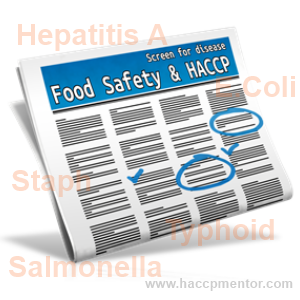So what is the best method to screen food handlers for Food-borne illness like hepatitis A, Staph, E.Coli and Salmonella? This episode of HACCP Mentor Review covers this along with scale calibration, export risks and food product traceability.
Watch Video
Transcript
Welcome
Welcome to HACCP Mentor Review Episode 28. I am Amanda Evans and in this episode we cover internal calibration test methods for bench scales, screening food handlers for disease, product traceability and export risks.
Calibrating Bench scales
When you perform internal calibration of your digital bench scales, you should be using two different methods to test. This includes the four edge method and Centre method. To complete the four edge method, place your calibrated weights in each of the four corners of the scale plate.
For the bench scale to be reading correctly, the display weight should be equal to sum of the calibrated weights used. To complete the centre method, place your calibrated weight in the middle or the centre of the scale plate. Again, for the bench scale to be reading correctly, the display weight should be the same as your calibrated weight that you used. If you find any issues whilst undertaking this test, you need to apply the applicable corrective action.
Food Poisoning Outbreak
The recent cyclospora outbreak from the USA has finally been linked to a source. The source of the outbreak has been identified as salad mix. The salad mix was supplied out of a farm in Mexico. To date, there have been over 400 cases confirmed.
How fast can you trace your food product
It is a requirement of the majority of GFSI standards to be able to trace your product both forwards to the customer and backwards to the raw material provider. If you were ever in a situation where you had to recall your food product, or trace your product, you want to be able to do this as quickly as possible. Check your certification standard to see if there has been a time limit defined. The BRC standard states that full traceability should be achievable within four hours.
Export risks
Fonterra in New Zealand has issued a recall notice regarding several batches of its whey protein which has been possibly contaminated with clostridium botulinum. It is interesting to note that 90% of China’s imported milk comes from New Zealand with Fonterra being the biggest single supplier.
The Ministry of Primary industries in New Zealand has reported that some market closures have occurred due to this food recall. Chinese authorities have suspended imports of Fonterra produced whey powder and Dairy Base powder, and increased inspection and supervision at the border for New Zealand dairy products. Russia appears to have a temporary ban on all New Zealand dairy exports.
This is a great example of making sure that you have covered all risks associated with your export countries or trading partners including potential market closure. Your food business contingency plan should document your risk assessment and action to be taken if your business is ever faced with a similar market closure issue.
Action of the week
This episodes action item go and check that all work in progress has been suitably identified. You should be able to identify what the product is and also what the shelf life of all work in progress.
Help with audit CARs available
If you need help with identifying what you need to do to close out audit CARs check out www.haccpmanual.com. This is a new project of mine to help food businesses get through the audit process with as little pain as possible.
Screening employees for disease 
Food handler health is in the media again with a recent notification of hepatitis A of a pizza shop worker in the state of Utah, USA. This of course is not the first time a food business employee has found been found to be diagnosed with a foodborne disease. So what is the best method to screen food handlers for Foodborne illness? Here are a few I recommend:
- Medical screen prior to employment – this involves not only diagnostic testing but also having a detailed medical history communicated.
- Random medical tests can be undertaken where nasal swabs, stool and blood samples are tested for common food borne diseases.
- Employee questionnaires can be completed to identify potential sources of contamination including recent travel overseas, family illness and access to family pets including chickens, birds, turtles, guinea pigs.
Keep in mind that screening employees for disease does not replace the need for good hygiene practices throughout the food handling process.
Wrap Up
That’s it for another episode of HACCP Mentor Review. Thanks for taking the time to check out the information. As always, if you have any feedback please leave a comment below this episode. Until next time, I am Amanda Evans from www.haccpmentor.com.



